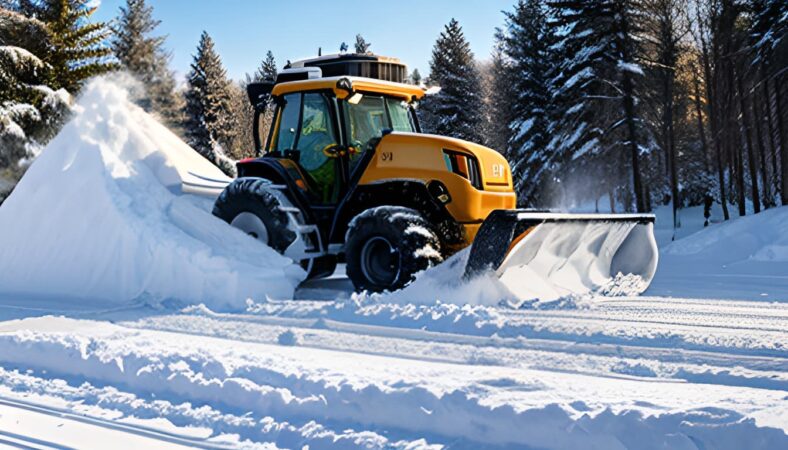The first snowfall may look beautiful, but it also creates legal obligations for homeowners and businesses. Failure to promptly and properly clear snow and ice from sidewalks, driveways and parking lots can lead to fines or even lawsuits if someone gets injured. That’s why understanding your local commercial snow and ice management services laws and regulations is critical to avoid expensive penalties or liability issues. This article provides an overview of common regulations related to clearing snow from both public and private property. We’ll examine key laws dictating timeframes, responsibility, and consequences for non-compliance. Whether you shovel your own walkways or hire professional commercial snow and ice management services, it’s vital to know the rules in your area so you can remove snow and ice safely and legally. Keep reading to learn more about your rights and responsibilities when it comes to snow removal on public and private property.
Public Property Laws and Regulations
One of the most common snow removal rules requires clearing public walkways like sidewalks within a certain timeframe after snowfall. For example, many municipalities require residential properties to clear sidewalks within 24 hours following a snowstorm. Commercial properties often have even tighter deadlines, sometimes as little as 3 hours, to clear sidewalks after the snow stops. Failure to meet these deadlines can result in fines, which increase with each day the area remains unshoveled. Fines range from $50-150 for a first offense up to higher amounts for repeated violations. Some cities will even dispatch crews to clear the sidewalk and bill the property owner if not addressed promptly. Beyond fines, uncleared public walkways can open you up to liability if a pedestrian slips and injures themselves due to snow and ice that should have been removed. Courts have frequently ruled in favor of plaintiffs in such cases when property owners failed to meet snow-clearing requirements. Commercial properties like retail shops and restaurants have a higher responsibility to maintain safe walkways for customers as high foot traffic is part of their business. Residential areas have slightly more flexibility if residents are traveling or unable to shovel for health reasons. However, the majority of areas mandate snow removal from public walkways within 24 hours of snowfall.
Private Property and Right-of-Way Rules
When it comes to private property, homeowners and businesses are responsible for clearing snow from driveways, parking lots, and walkways. Complexes like apartments and condos often have rules designating snow removal responsibilities – whether it’s a contracted service or residents shoveling. Check any HOA or rental rules. Frustration can arise when city snow plows dump snow from streets onto cleared driveways and sidewalks. In most cases, the city has a right-of-way allowing them to pile snow on private property near the curb. You still must re-clear these areas, even if covered by plows. Many cities prohibit pushing snow back into streets, as it can freeze into hazardous piles. Some have ordinances restricting curb snow height to improve driveway access. When in doubt, avoid pushing snow into streets and re-shovel areas impacted by plows. Clear any fire hydrants or storm drains covered by plowed snow too. If facing large amounts of snow, utilize emergency snow removal services to promptly clear driveways, parking lots, and walkways.
Unique Local Regulations
Some cities have unique snow rules like Boston’s Space Saver program, which allows residents to reserve shoveled street parking spots with items like old chairs. Burlington, VT prohibits dumping snow in public bike lanes. Many municipalities impose parking restrictions during snow emergencies to allow plow access. Be sure to know any unusual local snow removal regulations.
Enforcing Laws and Penalizing Noncompliance
Local police and code enforcement officers typically enforce snow clearing laws. Exact fines vary but noncompliance penalties often start around $50 for first violations, increasing for repeat offenses. Failure to clear snow may also result in the city removing snow and charging the property owner. Unshoveled snow can potentially even lead to lawsuits if someone is injured. Strictly abide by snow removal rules to avoid citations or legal issues.
Tips for Avoiding Issues
The best way to avoid fines or legal problems is to promptly clear snow and ice as required by local laws, within a reasonable timeframe after snowfall. Document your efforts by taking dated photos or video. Use common sense precautions like closing off slick areas until deicer can be applied. Post signage alerting people to icy conditions. Report any hazardous sidewalks or property violations to the city. Hiring reputable snow removal companies can also help ensure compliance and limit liability if injuries occur. When in doubt, go the extra mile with snow clearing to keep your property safe. Following these tips will help minimize issues with local snow removal regulations.
Conclusion
In summary, snow removal laws exist to ensure community safety and accessibility after storms. Both public agencies and private citizens share in the responsibility. Know your obligations, clear snow promptly, and take care to comply with local ordinances. With teamwork and planning, we can keep winter weather from hampering our communities.
